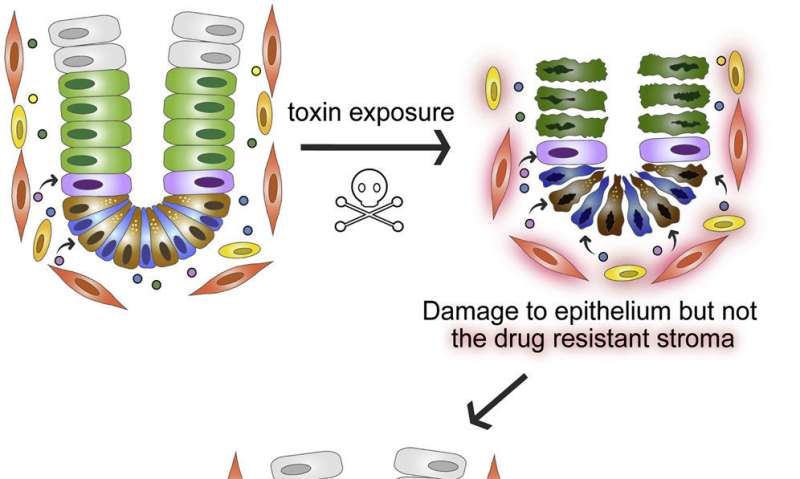Cellular pumps protect the gut from toxins

The master regulators of gut stem cells, called intestinal myofibroblasts, have pumps that protect them, and thus the gut, from the toxic effects of a wide range of compounds, including the anticancer drug tamoxifen, according to an investigation led by Duke-NUS Medical School.
"We have identified a unique population of cells that are master regulators of gut stem cells. These important support cells are uniquely protected from drugs and toxins in the diet," explains Professor David Virshup, director of Duke-NUS' Cancer and Stem Cell Biology Research Programme and one of the study's authors. "This allows you to take strong medicines and eat spicy foods without affecting your gut stem cell population. These master regulator cells are intrinsically drug resistant."
The intestinal lining is made of epithelial cells that live only three to five days, are continuously replaced, and can regenerate following injury. This continuous replacement is due to the presence of stem cells in crypts found within the intestinal lining. The cells surrounding these crypts provide a supportive microenvironment that controls stem cell function. Some of these supporting cells, including myofibroblasts, make signalling molecules called Wnt proteins. The proteins combine with receptors on stem cells to control the expression of genes involved in regulating stem cell proliferation and differentiation.
Wnt signalling also plays a role in promoting tumour growth, so there is much interest in developing drugs that inhibit it. But there is concern that doing so could be toxic to the gut by damaging the stem cell microenvironment. Surprisingly, compounds that inhibit the secretion of Wnt proteins, called PORCN inhibitors, have limited toxicity on the gut. Other compounds that inhibit Wnt signalling by acting directly on stem cells, on the other hand, are toxic.
Researchers at Duke-NUS Medical School in Singapore and international colleagues conducted experiments on mice and cultured cells and found that myofibroblasts were resistant to the toxic effects of a range of 'xenobiotics': foreign compounds that are not naturally produced by the body. This included resistance to drugs designed to inhibit Wnt secretion. The resistance was found to be due, at least in part, to the presence of specific 'drug efflux pumps', which can actively remove toxic compounds from within the cells. These pumps protect myofibroblasts when other intestinal cells might be affected, allowing them to continue the crucial Wnt signalling for intestinal regeneration.
"Xenobiotic resistance of the Wnt-producing myofibroblasts can protect the intestinal stem cell niche in the face of an unpredictable environment," says Assistant Professor Babita Madan, the study's lead contact and a biochemist with the Cancer and Stem Cell Biology Programme.
Other researchers have found that similar cellular pumps within cancer cells can make people resistant to cancer treatments. Compounds that turn these pumps off could enhance their efficacy. Based on the current study, the Duke-NUS researchers and their colleagues caution these compounds might also be toxic to the intestine.
More information: Chee, Y. C., Pahnke, J., Adsool, V. A., Madan, B., & Virshup, D. M. (2018). Intrinsic Xenobiotic Resistance of the Intestinal Stem Cell Niche. Developmental Cell. DOI: 10.1016/j.devcel.2018.07.023


















